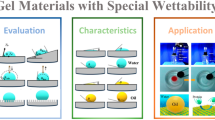Abstract
Recently high-strength and high-functional gels have been developed and are expected to be used in industrial and the medical fields. However, the research of gel application has not made much progress from the reason why an environmental range to use being small and properties of matter evaluation are not performed enough. To control the surface friction of gel mechanical materials by the electric field, here we study the effect of the applied voltage on the frictional properties of double-network gel (DN gel) with high strength. We found that impressed voltage on the gel has an ability to control the frictional force of the hydrogel. The results of the tensile and compression tests showed that the behavior of the DN gel was similar to a rubber, and effective data as mechanical materials were obtained. The results of friction measurement using reciprocating friction tester showed that the coefficients of friction depend on the sliding velocities. In the case of the cathode measurement ball, the coefficients of friction decreased with increase in voltage in the range of 0.0–3.0 V and increased with increase in the applied voltage in the range of 3.0–5.0 V. In the case of the anode measurement ball, the coefficient of friction increased with increase in the voltage. The current value measurement was performed in a measurement ball and a stainless-steel plate, and the electric current flowed at approximately 2.5 V and above. It is considered that the applied voltage controls the thickness of water lubricant layer and change the coefficient of friction of the gel. These findings provide a new insight into our understandings of application of the high-performance gels device as well as the development of high-performance gel materials.
















Similar content being viewed by others
References
Gong JP (2006) Friction and lubrication of hydrogels-its richness and complexity. Soft Matter 2:544–552
Gong JP, Katsuyama Y, Kurokawa T, Osada Y (2003) Double-Network Hydrogels with Extremely High Mechanical Strength. Adv Mater 15:1155–1158
Mukai K, Asaka K, Sugino T, Kiyohara K, Takeuchi I, Terasawa N, Futaba DN, Hata K, Fukushima T, Aida T (2009) Highly conductive sheets from millimeter-long single-walled carbon nanotubes and ionic liquids: application to fast-moving, low-voltage electromechanical actuators operable in air. Adv Mater 21:1582–1585
Muroi H, Hidema R, Gong J, Furukawa H (2013) Development of optical 3D gel printer for fabricating free-form soft & wet industrial materials and evaluation of printed double-network gels. J Solid Mech Master Eng 7:163–168
Takata M, Yamaguchi T, Gong JP, Doi M (2009) Electric field effect on the sliding friction of a charged gel. J Phys Soc Jpn 78:084602
Wada M, Hidema R, Chiba T, Yamada K, Yamada N, Gong J, Furukawa H (2013) Surface and bulk mechanical properties of soft and wet materials. J Solid Mech Mater Eng 7:235–244
Yokoo T, Hidema R, Furukawa H (2011) Novel optical device developed with high-strength double-network gels. J Solid Mech Mater Eng 5:1015–2021
Acknowledgements
This study was partly supported by the Grant-in-Aid for Scientific Research (Category B, Project No.: 25288094, etc.) from the Japan Society for the Promotion of Science (JSPS), the national project named “Green Tribology Innovation Network” in the area of Advanced Environmental Materials, Green Network of Excellence (GRENE), the Innovative Innovation Generation Program (Center Of Innovation, COI-T) from the JST and the Ministry of Education, Culture, Sports, Science and Technology (MEXT) in Japan, the Regional Open Innovation Promotion Project from the Ministry of Economy in Japan, and the Strategic Innovation Creation Project (SIP) from the New Energy and Industrial Technology Development Organization (NEDO) of Japan.
Author information
Authors and Affiliations
Corresponding author
Ethics declarations
Conflict of interest
Authors declare that there is no conflict of interest.
Rights and permissions
About this article
Cite this article
Wada, M., Yamada, K., Kameyama, T. et al. Electric control of friction on surface of high-strength hydrogels. Microsyst Technol 24, 639–646 (2018). https://doi.org/10.1007/s00542-017-3417-6
Received:
Accepted:
Published:
Issue Date:
DOI: https://doi.org/10.1007/s00542-017-3417-6




